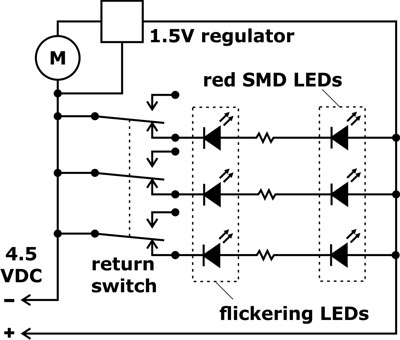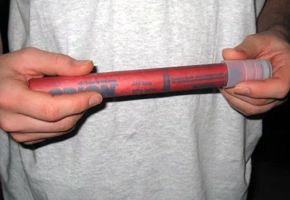Emergency Road Flares
This one went from an idea to a project as I developed a new construction site diorama featuring a disabled tractor trailer. My idea was simple: use fiber optics and flickering LEDs to create emergency flares, a.k.a fusees. The visible part of the fiber would be painted red; the other end of the fiber would be inserted into a hole drilled in the end of a red flickering LED.
Unfortunately, after testing this idea, it didn't work. Even "superbright" LEDs can't deliver enough light through a single fiber to look believable. But I wasn't giving up: my next idea was to use red prewired 0402 SMD LEDs sticking out of the street; I simply wired them in series with flickering LEDs to produce the desired effect.
Optional Animation
Okay, want to really mess with people's heads? Attach the wire leads from the LEDs to a motorized drive that runs very slowly, so that the flares get shorter over time. Since the movement would not be immediately evident, most people would probably never notice... until you bring it to their attention a couple of minutes later...


And, on 24 August 2022, I turned that insane notion into reality. I started with a low-RPM geared motor to which I attached a worm that engages a large worm gear, thus providing nice slow movement. The worm gear has a spiral-shaped cam; the cam follower then moves a lever that in turn moves the LEDs. The cam also allows the follower to return quickly to its starting position; during this return movement, microswitches shut off the LEDs, since it would be absurd to see them return to their original length while lit. (Of course, seeing them magically return to their full length even unlit is absurd, but we won't go there; at least, not being lit, they're not drawing as much attention to themselves.)

The mechanism is a fairly simple one (above); ordinarily I'd have knocked it out in a day, except... that spiral cam was really tough. Just that one part took the better part of a day to get right (below left)—I have a small pile of rejects to show for it. The final result isn't perfect, but it's good enough that, at such a slow rate of movement, the flaws are unnoticeable.


The LED leads are threaded through brass tubes embedded in the street, down to an anchor flexibly connected to the end of the lever (above right) that's moved by the cam follower. I bonded the wires to the anchor in the lowermost or "burned out" position so that I could accurately position the LEDs right at the street surface; I also made sure the LEDs faced the normal viewing angle for maximum brightness.

Out of necessity, the mechanism and the street are one unit, and drop into the diorama together. Since this portion of the street conveniently runs from the grade crossing to the back of the diorama, there were no joints to disguise (above).

The cycle takes about 4 minutes—slightly fast, as real flares burn between 5 and 60 minutes—but I doubt anyone is going to stand there carefully watching them to see how long they last. Incidentally, the LEDs are switched individually, rather than all together, so they don't all go out and come back on at once. Of course, all of this would likely go unnoticed unless I pointed it out; it's just "I did it because I could" stuff. Oh, and... I was tempted—for just a few minutes—to add a smoke unit, since flares are notoriously smoky. But I came to my senses just in time.
|
|
This may be the oddest, most subtle animation I've ever done. It's a shame it's at the very back of the diorama, but I didn't have much choice—there wasn't anyplace else where the mechanism would fit.
Reference



